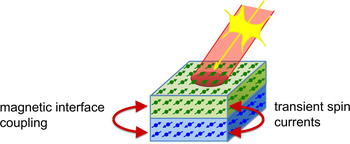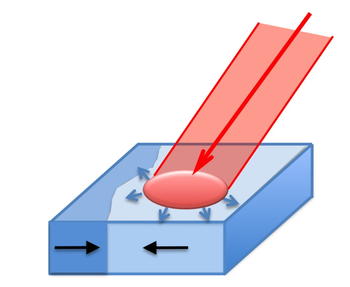A07 - Bridging the time scales between ultrafast and precessional magnetization dynamics
Role of interface of layered systems
Lateral spread of local excitation and interaction with magnetic domain structure
The project aims on identifying and understanding the relevant mechanisms linking the ultrafast processes to the magnetization dynamics following on longer timescales. The motivation is to gain a comprehensive insight into the interplay of ultrafast demagnetization, spin currents, and thermal effects in order to control the dynamic behavior on all timescales, including the time it takes for the system to settle back into a stable and addressable state.
The response of layered magnetic thin-film systems following optical excitation by femtosecond infrared laser pulses is studied by x-ray absorption spectroscopy and microscopy on different timescales, from 100 fs up to nanoseconds. One part of the project focuses on the role of interfaces between layers of different spin structures for the evolution of the spin order across these different timescales. The ultrafast magnetization dynamics is measured in pump–probe mode with laser pump and x-ray magnetic circular dichroism (XMCD) or magnetic linear dichroism (XMLD) probe. Systems include antiferromagnetic/ferromagnetic and ferromagnetic/ferrimagnetic bilayers as well as transition metal dichalchogenides interfaced with ferromagnetic metals.
In a second part, lateral resolution from photoelectron emission microscopy (PEEM) with XMCD and XMLD as contrast mechanism is used to study the lateral propagation of excitations of the spin system and its influence on and interaction with magnetic domain walls. The spatiotemporal evolution of the magnetization after excitation by an infrared laser pulse is studied either in pump–probe mode or by examining the static situation after one individual or a sequence of two time-delayed ultrashort laser pulses. Besides exciting the electronic system on the ultrafast time scale, infrared laser pulses also lead to a temperature gradient in the sample, which persists on a longer timescale and triggers electronic as well as magnonic spin currents both in the vertical as well as in the lateral direction. These transient spin currents interact with the local spin structure of the sample, providing on the one hand a means to manipulate magnetic domains, on the other hand may be guided by a magnetically patterned sample. Here the systems under study are single ferro- and ferrimagnetic layers such as Fe, Ni, and FeGd, bilayers containing NiO or CoO as antiferromagnetic material, as well as trilayers in which two ferromagnetic materials are separated by a nonferromagnetic spacer layer.
The results will help to tailor the dynamic response by the design of the system, bridging the gap between experiments targeting the ultrafast response of magnetic systems after different excitations and experiments exploring the dynamics on the timescale above 10 ps.
Publications (2nd Funding Period 2022 - 2025)
- Accelerated ultrafast demagnetization of an interlayer-exchange-coupled Co/Mn/Co trilayer
J. Gördes, I. Kumberg, C. S. Awsaf, M. Walter, T. Shinwari, S. Thakur, S. Sharma, C. Schüßler-Langeheine, N. Pontius, and W. Kuch
Phys. Rev. B 112, 104442 (2025) - DOI: 10.1103/h2cw-hdvm
- Growth of MnxAu1-x films on Cu(001) and Ag(001) single-crystal substrates
I. Gelen, T. Shinwari, I. Kumberg, S. E. Hadjadj, Y. A. Shokr, E. Golias, and W. Kuch
Phys. Status Solidi B 261, 2300518 (2024) - DOI: 10.1002/pssb.202300518
- Ultrafast laser-induced magneto-optical changes in resonant magnetic x-ray reflectivity
I. Kumberg, E. Golias, S. E. Hadjadj, R. Hosseinifar, S. Thakur, T. Shinwari, I. Gelen, N. Pontius, C. Schüßler-Langeheine, C. von Korff Schmising, S. Sharma, and W. Kuch
Phys. Rev. B 108, 054439 (2023) - DOI: 10.1103/PhysRevB.108.054439
- Influence of magnetic domain walls on all-optical magnetic toggle switching in a ferrimagnetic GdFe film
R. Hosseinifar, E. Golias, I. Kumberg, Q. Guillet, K. Frischmuth, S. Thakur, M. Fix, M. Albrecht, F. Kronast, and W. Kuch
Beilstein J. Nantechnol. 13, 74 (2022) - DOI: 10.3762/bjnano.13.5
Publications (1st Funding Period 2018 - 2021)
-
Ultrafast optically induced ferromagnetic state in an elemental antiferromagnet
E. Golias, I. Kumberg, I. Gelen, S. Thakur, J. Gördes, R. Hosseinifar, Q. Guillet, J. K. Dewhurst, S. Sharma, C. Schüßler-Langeheine, N. Pontius, and W. Kuch
Phys. Rev. Lett. 126, 107202 (2021) - DOI: 10.1103/PhysRevLett.126.107202 -
Accelerating the laser-induced demagnetization of a ferromagnetic film by antiferromagnetic order in an adjacent layer
I. Kumberg, E. Golias, N. Pontius, R. Hosseinifar, K. Frischmuth, I. Gelen, T. Shinwari, S. Thakur, C. Schüßler-Langeheine, P. M. Oppeneer, and W. Kuch
Phys. Rev. B 102, 214418 (2020) - DOI: 10.1103/PhysRevB.102.214418 -
Steering of magnetic domain walls by single ultrashort laser pulses
Y. A. Shokr, O. Sandig, M. Erkovan, B. Zhang, M. Bernien, A. A. Ünal, F. Kronast, U. Parlak, J. Vogel, and W. Kuch
Phys. Rev. B 99, 214404 (2019) - DOI: 10.1103/PhysRevB.99.214404


